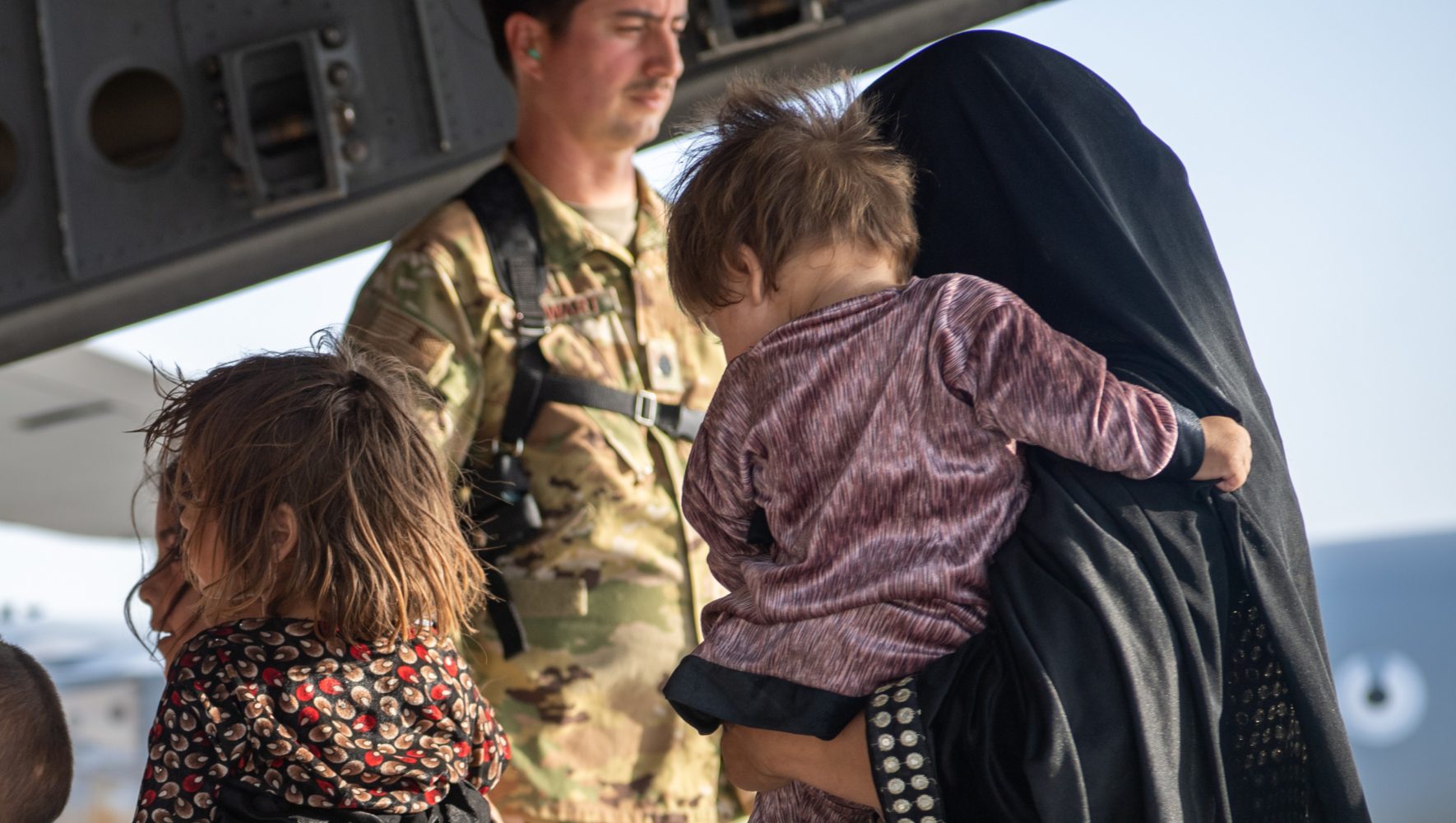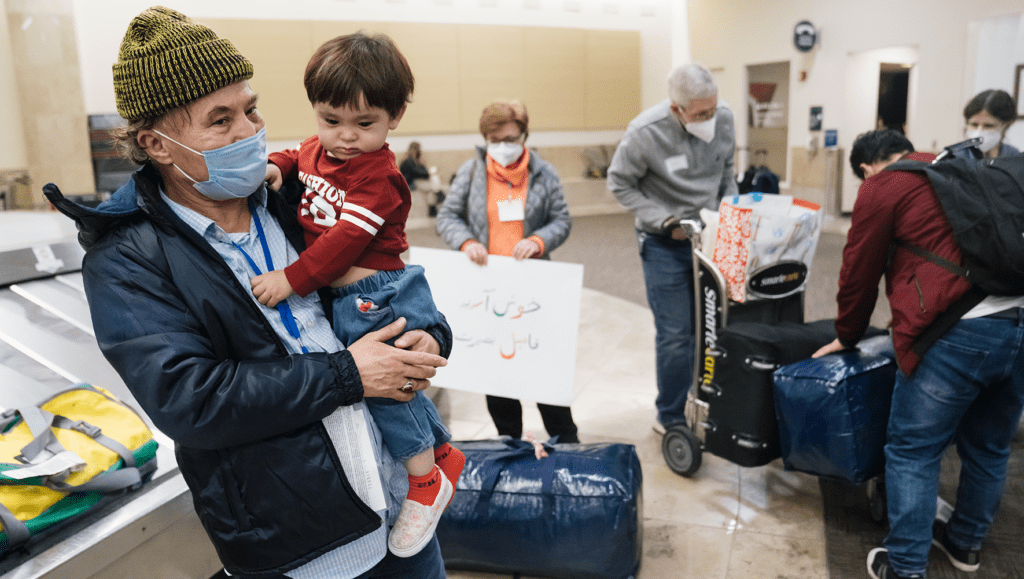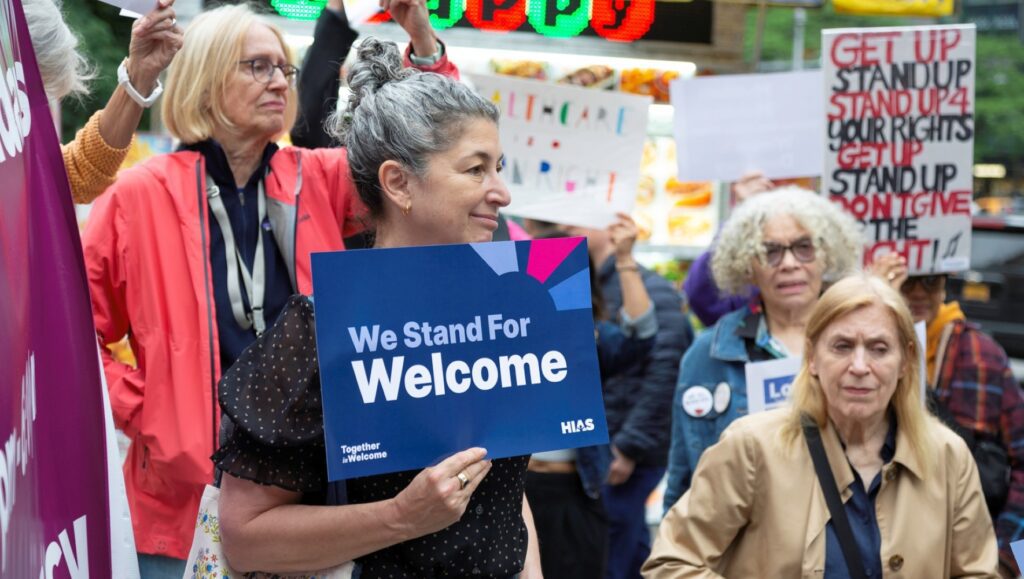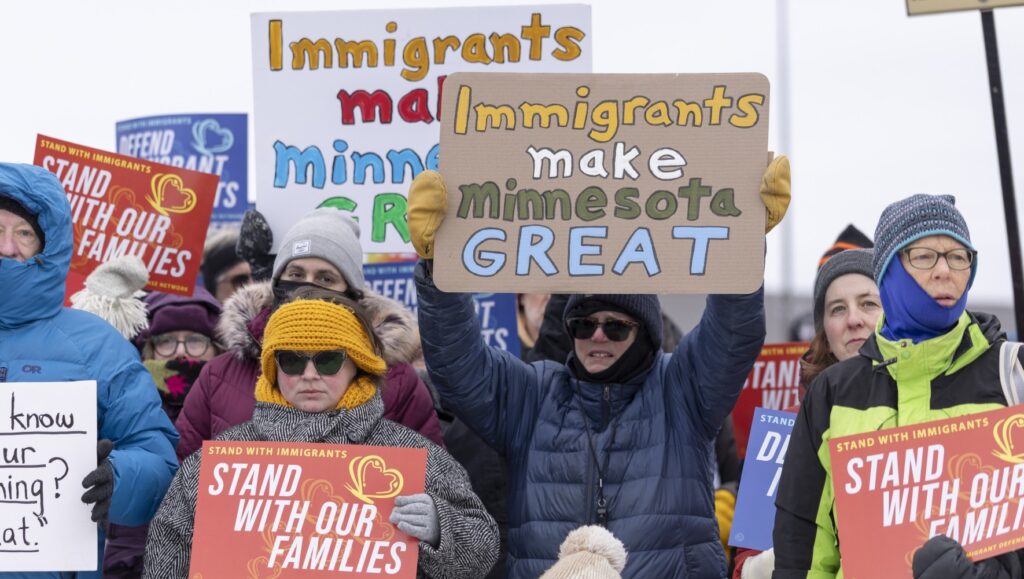
At 1 a.m. on August 21, 2021, Maryam* got the call she had been anxiously awaiting. She was told to get to the Kabul airport within half an hour and to bring nothing with her. For over a decade, Maryam had been an outspoken advocate for women’s rights in Afghanistan, led women’s health-related projects funded by the U.S. government, and founded an organization promoting women’s rights and health in impoverished areas. But all these initiatives now put her at risk under the new Taliban regime. Maryam’s family had spent the week after the fall of Kabul on August 15 hiding in their home with her brother, Ahmad* — who was also at risk due to his 15 years as a high-ranking government official — and his family.
Outside the airport, she waited about 12 hours, neck deep in sewage water, before she could enter. Once inside, she waited two more days for an evacuation flight, still wearing her dirty clothes. But it was worth it: She was on the path to safety with her husband and three children.
Amid the chaos of the U.S. withdrawal from Afghanistan that August, Maryam and her family were among the over 70,000 Afghans, many of whom had worked closely with the American government, who were evacuated to the U.S. But thousands of others unable to escape during the evacuation, such as Ahmad, were not as fortunate. While Maryam and her family were welcomed with open arms, Ahmad and his family endured an arduous journey to get to the United States, only to face an uncertain future upon arrival. The divergent fortunes of two members of the same family illustrate how, three years after the fall of Kabul, the fates of those who fled for safety remain far from settled.
“When I evacuated from Afghanistan, I had a lot of hope that [my brother] would follow me after a few days,” Maryam said. “I did not know that he would be left behind.”
A Perilous Journey
After Afghanistan’s government collapsed, Ahmad, his wife, and his three children spent over two weeks in hiding while he tried to coordinate their evacuation. During this time, the Taliban searched his home twice and attempted to lure him outside by posing on the phone as an NGO offering to coordinate an evacuation. This wasn’t Ahmad’s first run-in with the Taliban: He received several death threats from the group when he worked for the Afghan government, during which he also volunteered with the women’s rights organization that Maryam had established. But with the extremist group now back in power, this time was different.
Fearing for their safety and with no clear path to the U.S., Ahmad’s family decided to flee. They crossed the border into Iran on August 30, 2021, and the following year traveled to Brazil after receiving temporary humanitarian parole there. They then made their way north to the U.S.-Mexico border in the hope of reuniting with Maryam and her family in the United States, taking a perilous path through eight more countries. While traveling by boat between Colombia and Panama, the family witnessed a boat accident that killed dozens of people. His youngest daughter, then two years old, spoke her first words on that voyage: “Mommy, I’m scared.”
“These months were like a horrible nightmare,” said Ahmad. “At any moment, there was no guarantee of safety. We saw death, several times, in front of our eyes.”
“When I evacuated from Afghanistan, I had a lot of hope that [my brother] would follow me after a few days. I did not know that he would be left behind.”Maryam*, an Afghan evacuee and HIAS legal client
The Fight for Asylum
Upon arrival in the U.S., Afghans who were evacuated in the immediate aftermath of the Taliban takeover were granted a temporary status of humanitarian parole that allowed them to live and work in the U.S. for two years. They were provided with initial resettlement and other benefits like those given to refugees, and their applications for asylum were expedited under an act of Congress.
When Maryam’s family arrived in Maryland, they were provided with housing and assigned a case worker who helped them access benefits like healthcare and food stamps and enroll the children in schools.
“These things made my life much easier, until gradually I learned how to do them for myself,” she said.
With assistance from HIAS, Maryam applied for asylum in May 2022 in order to obtain permanent status in the U.S. Because of her status as a parolee, she was able to apply for asylum affirmatively, which is intended to be a less adversarial process available to people who are not subject to removal from the U.S. She was granted asylum in September 2023, less than a year after she applied.
But Ahmad, like thousands of Afghans who were left behind during the evacuation and have subsequently sought asylum at the U.S.-Mexico border after they were unable to evacuate, received a much less welcoming introduction to the U.S.
When his family crossed into the United States from Mexico in November 2022, they were apprehended by border patrol, held at a detention center for over a week, and placed in removal proceedings. This meant that his asylum case would go through the grueling defensive asylum process, which takes place in immigration court.
Unlike many asylum seekers, Ahmad was fortunate that his sister and her family were already here to help guide him. The families reunited in Maryland, where for months the four adults and six children lived together in a two-bedroom apartment.
“When [Ahmad’s family] came, there was no help,” said Maryam. “We figured out everything by ourselves.”
The siblings approached a number of organizations in the D.C. area to try to get Ahmad’s family help, but were told it was not possible. Just as he was beginning to lose hope, Maryam told him to reach out to her lawyer at HIAS, Shayan Davoudi. Davoudi took on Ahmad’s case and connected him to other forms of assistance through HIAS’ social services department and community groups.
“HIAS, and having Shayan as my lawyer, are a big part of why I feel supported and comfortable here,” said Ahmad. “It gave me hope again to be strong and continue on. Shayan supports our family, not only as a lawyer; he tries to support me emotionally and psychologically to be able to establish my life and take care of my family.”
“HIAS, and having Shayan as my lawyer, are a big part of why I feel supported and comfortable here. It gave me hope again to be strong and continue on."Ahmad, an Afghan asylee and HIAS legal client
Unfortunately, few others in Ahmad’s position have received this level of support. Across the U.S., there is a shortage of free or low-cost legal representation available to asylum seekers facing an extremely complex immigration system — a system made even more difficult to navigate by restrictive policies such as the asylum ban and border shutdown executive action. For Afghans, this shortage is compounded by inadequate funding devoted to their cases and too few lawyers and interpreters who can communicate with clients in Dari or Pashto. HIAS is one of only a few organizations in the D.C. area with funding to provide services to clients such as Ahmad, but that funding is restricted to those living in a single county in Maryland. The demand for such services nationwide vastly exceeds current capacity.
“There are thousands of Afghans in this position, facing deportation with no access to legal representation or any other supports,” said Stephen Brown, HIAS’ director of immigration legal services. “These are incredibly strong asylum cases given conditions in Afghanistan and have a high likelihood of success if they could just find representation to help them present their case.”
In June 2024, Ahmad and his family were granted asylum in the U.S., ending a period of uncertainty that had lasted nearly three years. Today, both Ahmad and Maryam’s families are feeling more settled. Ahmad works as a lab technician, and Maryam serves as a technical advisor. Their children are in school, and Maryam is working to establish a new organization along with other Afghan women who fled Taliban rule to continue their advocacy on behalf of women in Afghanistan.
“We’re trying to bring attention back,” said Maryam, who feels that the world has begun normalizing the Taliban’s restrictive treatment of women and girls. “No matter what will happen, we will go on fighting.”
* Pseudonym used for client’s protection


